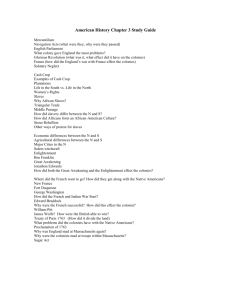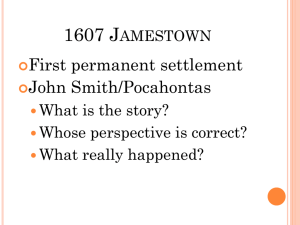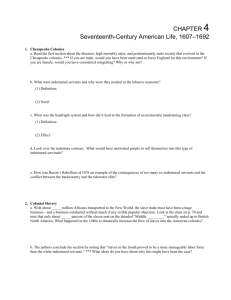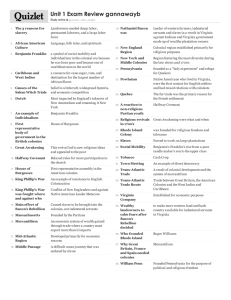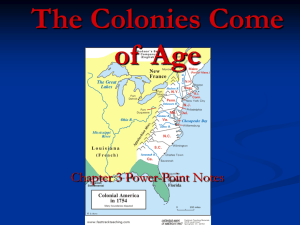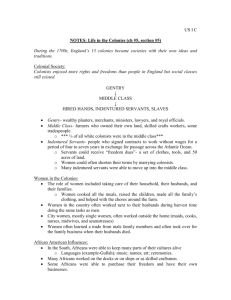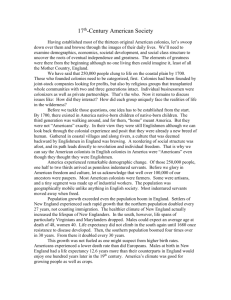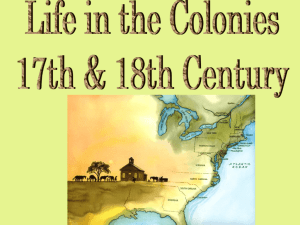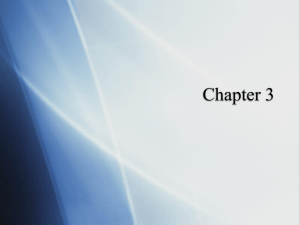Colonial Society in the 17th Century
advertisement
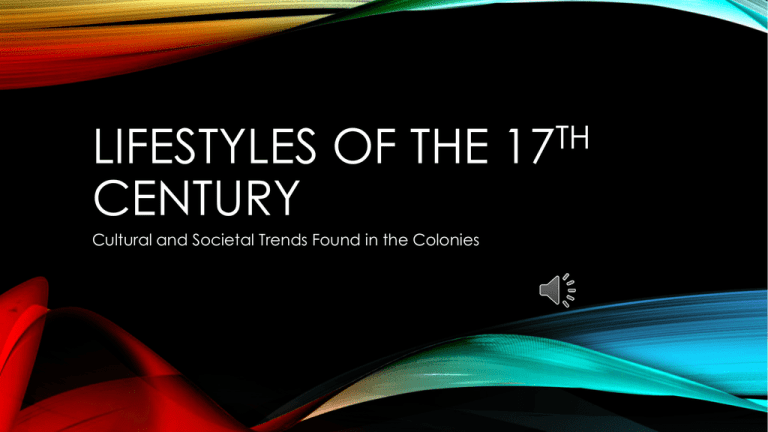
LIFESTYLES OF THE CENTURY Cultural and Societal Trends Found in the Colonies TH 17 NEW ENGLAND/MIDDLE COLONIES – SOCIETAL STRUCTURE • New England society was structured around the meetinghouse (served as a place of worship and as a town hall) • Larger towns required elementary education • Heavy emphasis on religion– wanted to remain closely tied to Puritan roots • As people moved further from the towns, keeping them tied to religion became more important • Ministers implemented the Half-Way Covenant in 1662 • Church began admitting the children of members IF they had been baptized (but not taken full communion) NEW ENGLAND/MIDDLE COLONIES – FAMILY STRUCTURE • Better air quality: colonists live longer! • Migrated as families, lived as families • Women did not have the right to vote– Puritan lawmakers feared it would undercut the marriage • Children grew up in homes of obedience • Population grew as fertility increased NEW ENGLAND – ETHNIC DIVERSITY • Very little– most were Protestant and English • Very few slaves • Diversity instead based on RELIGION/BELIEFS, rather than country of origin. MIDDLE COLONIES– ETHNIC DIVERSITY • Very diverse- immigrants from various European countries who were not welcomed in New England came to the middle colonies for refuge • Germans, Scots-Irish, Swiss and the Dutch all carved out settlements • Many languages, many religions SOUTHERN COLONIES- SOCIETAL STRUCTURE • Defined hierarchy • Large plantation owners • Small farmers (largest group)– one to five slaves • Landless whites • Indentured servants • Black slaves • Differentiated between slaves and servants on the basis of race. • Large plantations= very few large cities; people were too spread out! SOUTHERN COLONIES- FAMILY STRUCTURE • Southern women experiences greater rights than northern women • Men tended to die earlier, leaving the women with vast properties • Life revolved around the plantation– education was not seen as very important SOUTHERN COLONIES- ETHNIC DIVERSITY • Mostly English, though the occasional grouping of immigrants, such as the Scots Highlanders in SE North Carolina • LARGE African slave population led to an ‘AfricanAmerican’ culture • Blending of African and American speech, religion and folkways–> Gullah • Ringshout: contributed to the development of jazz COLONIAL SLAVERY • Major change in agriculture during the 1680s= greater importation of slaves. Why was this happening? • Rising wages in England meant that there was a DECREASE in the number of poor Englishmen coming to the colonies. • Rising fear of free indentured servants • Slaves were imported from West Africa, and placed on ship MIDDLE PASSAGE • Importation of slaves was part of the ‘Middle Passage’: the ‘middle’ portion of the Triangular Trade Route • Slaves were forced to march to the African coast, branded and bound and loaded onto ships • Lived in tight, unsanitary conditions on ships • Death rates ~20% BACON’S REBELLION- THE BACKSTORY • Not all Englishmen were happy with their situation. Some Englishmen were forced into indentured servitude upon arrival in America. • Upon finishing their time as indentured servants, they were set free, and SUPPOSED to be given land. • But, all the good land was already taken… • Other grievances: • Colonial policies ‘too friendly’ towards Native Americans • No women to marry! BACON’S REBELLION • In 1676, a group of ~1,000 Virginians, led by Nathanial Bacon, took matters into their own hands. This was known as Bacon’s Rebellion. • They murdered the Native Americans in the area (both friendly and hostile); • They chased the governor, William Berkeley from Jamestown • Burned the capital • Rebellion died with Bacon, as Berkeley soon gained enough support to combat the rebellious frontiersmen. • Importance? It sets the stage for the revolution that will occur in the next century. COMPARING THE COLONIES AND EUROPE Europe (Old World) • Government: monarchy (kings and queens) • Freedoms: property holders could vote (males only!) • Religious diversity: varied by country- not much diversity in a single country • Ethnic diversity: varied by countrynot much diversity in a single country Colonies (New World) • Government: beginnings of democracy– representation!!! • Freedoms: freedom of speech, religion, press and assembly • Religious diversity: denominations included: Congregationalists, Anglicans, Presbyterians, Lutherans, Quakers and Catholics • Ethnic diversity: settlers from all of Europe established colonies CLOSING QUESTION •How did exploration and colonization impact the New World? Think economically, physically and culturally. CHANGES IN THE COLONIES • Increased population • More settlers coming from Europe • Increased fertility of the colonists themselves • Religious revival, known as the Great Awakening. • Preachers such as Jonathan Edwards and George Whitefield feared colonists were getting too far away from religion and employed an evangelical style of preaching to draw back colonists to the church.
